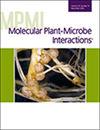Nicholas Rhoades, Todd A Naumann, Hye-Seon Kim, Gabdiel Yulfo-Soto, Susan McCormick, Michael J Bowman, Martha Vaughn, Guixia Hao
求助PDF
{"title":"小麦和大麦镰刀菌RGAE同源物是小麦和大麦初侵染的关键。","authors":"Nicholas Rhoades, Todd A Naumann, Hye-Seon Kim, Gabdiel Yulfo-Soto, Susan McCormick, Michael J Bowman, Martha Vaughn, Guixia Hao","doi":"10.1094/MPMI-03-25-0027-R","DOIUrl":null,"url":null,"abstract":"<p><p><i>Fusarium graminearum</i> is the primary causal agent of Fusarium head blight (FHB), a devastating fungal disease on wheat, barley, and other grains. During infection, <i>F. graminearum</i> produces trichothecene mycotoxins, predominately deoxynivalenol (DON), that contaminate grain and reduce grain yield and quality. Although DON functions as a virulence factor to promote <i>F. graminearum</i> spread in the wheat head, it is not essential for establishing initial infection in wheat or barley. When fungal pathogens, such as <i>F. graminearum</i>, infect a host plant, they secrete hundreds of protein effectors that interfere with plant immunity to promote disease. A recent study identified hundreds of putative effector-encoding genes that are conserved across six <i>Fusarium</i> species. In the current study, we selected a subset of 50 conserved effectors from <i>F. graminearum</i> PH-1 and determined their expression on wheat heads over a 7-day infection period. Gene expression analysis revealed that several genes were highly induced in wheat heads during fungal infection. One of them was a putative <u>r</u>hamno<u>g</u>alacturonan <u>a</u>cetyl<u>e</u>sterase homolog (<i>FgRGAE</i>), which was also highly induced in barley heads. FHB virulence assays showed that deletion mutants of <i>FgRGAE</i> significantly reduced initial infection and DON accumulation in wheat and barley heads compared with wild-type controls. Replacing the <i>FgRGAE</i>::<i>Hyg</i> deletion construct with an <i>FgRGAE<sup>ORF+</sup></i>::<i>Gen</i> construct at the native locus restored FHB disease to wild-type levels in both wheat and barley heads. <i>FgRGAE</i> may serve as an ideal target to reduce FHB and mycotoxin contamination in wheat and barley. [Formula: see text] Copyright © 2025 The Author(s). This is an open access article distributed under the CC BY-NC-ND 4.0 International license.</p>","PeriodicalId":19009,"journal":{"name":"Molecular Plant-microbe Interactions","volume":" ","pages":"MPMI03250027R"},"PeriodicalIF":3.4000,"publicationDate":"2025-10-06","publicationTypes":"Journal Article","fieldsOfStudy":null,"isOpenAccess":false,"openAccessPdf":"","citationCount":"0","resultStr":"{\"title\":\"An RGAE Homolog in <i>Fusarium graminearum</i> Is Critical for Initial Infection in Wheat and Barley.\",\"authors\":\"Nicholas Rhoades, Todd A Naumann, Hye-Seon Kim, Gabdiel Yulfo-Soto, Susan McCormick, Michael J Bowman, Martha Vaughn, Guixia Hao\",\"doi\":\"10.1094/MPMI-03-25-0027-R\",\"DOIUrl\":null,\"url\":null,\"abstract\":\"<p><p><i>Fusarium graminearum</i> is the primary causal agent of Fusarium head blight (FHB), a devastating fungal disease on wheat, barley, and other grains. During infection, <i>F. graminearum</i> produces trichothecene mycotoxins, predominately deoxynivalenol (DON), that contaminate grain and reduce grain yield and quality. Although DON functions as a virulence factor to promote <i>F. graminearum</i> spread in the wheat head, it is not essential for establishing initial infection in wheat or barley. When fungal pathogens, such as <i>F. graminearum</i>, infect a host plant, they secrete hundreds of protein effectors that interfere with plant immunity to promote disease. A recent study identified hundreds of putative effector-encoding genes that are conserved across six <i>Fusarium</i> species. In the current study, we selected a subset of 50 conserved effectors from <i>F. graminearum</i> PH-1 and determined their expression on wheat heads over a 7-day infection period. Gene expression analysis revealed that several genes were highly induced in wheat heads during fungal infection. One of them was a putative <u>r</u>hamno<u>g</u>alacturonan <u>a</u>cetyl<u>e</u>sterase homolog (<i>FgRGAE</i>), which was also highly induced in barley heads. FHB virulence assays showed that deletion mutants of <i>FgRGAE</i> significantly reduced initial infection and DON accumulation in wheat and barley heads compared with wild-type controls. Replacing the <i>FgRGAE</i>::<i>Hyg</i> deletion construct with an <i>FgRGAE<sup>ORF+</sup></i>::<i>Gen</i> construct at the native locus restored FHB disease to wild-type levels in both wheat and barley heads. <i>FgRGAE</i> may serve as an ideal target to reduce FHB and mycotoxin contamination in wheat and barley. [Formula: see text] Copyright © 2025 The Author(s). This is an open access article distributed under the CC BY-NC-ND 4.0 International license.</p>\",\"PeriodicalId\":19009,\"journal\":{\"name\":\"Molecular Plant-microbe Interactions\",\"volume\":\" \",\"pages\":\"MPMI03250027R\"},\"PeriodicalIF\":3.4000,\"publicationDate\":\"2025-10-06\",\"publicationTypes\":\"Journal Article\",\"fieldsOfStudy\":null,\"isOpenAccess\":false,\"openAccessPdf\":\"\",\"citationCount\":\"0\",\"resultStr\":null,\"platform\":\"Semanticscholar\",\"paperid\":null,\"PeriodicalName\":\"Molecular Plant-microbe Interactions\",\"FirstCategoryId\":\"99\",\"ListUrlMain\":\"https://doi.org/10.1094/MPMI-03-25-0027-R\",\"RegionNum\":3,\"RegionCategory\":\"生物学\",\"ArticlePicture\":[],\"TitleCN\":null,\"AbstractTextCN\":null,\"PMCID\":null,\"EPubDate\":\"\",\"PubModel\":\"\",\"JCR\":\"Q2\",\"JCRName\":\"BIOCHEMISTRY & MOLECULAR BIOLOGY\",\"Score\":null,\"Total\":0}","platform":"Semanticscholar","paperid":null,"PeriodicalName":"Molecular Plant-microbe Interactions","FirstCategoryId":"99","ListUrlMain":"https://doi.org/10.1094/MPMI-03-25-0027-R","RegionNum":3,"RegionCategory":"生物学","ArticlePicture":[],"TitleCN":null,"AbstractTextCN":null,"PMCID":null,"EPubDate":"","PubModel":"","JCR":"Q2","JCRName":"BIOCHEMISTRY & MOLECULAR BIOLOGY","Score":null,"Total":0}
引用次数: 0
引用
批量引用

 求助内容:
求助内容: 应助结果提醒方式:
应助结果提醒方式:


